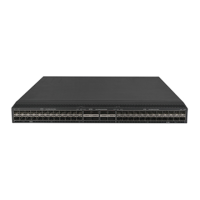12
Aggregation member port restrictions
Deleting an aggregate interface also deletes its aggregation group and causes all member ports to
leave the aggregation group.
An interface cannot join an aggregation group if it has different attribute configurations from the
aggregate interface. After joining an aggregation group, an interface inherits the attribute
configurations on the aggregate interface. You can modify the attribute configurations only on the
aggregate interface.
Do not assign a reflector port for port mirroring to an aggregation group. For more information about
reflector ports, see Network Management and Monitoring Configuration Guide.
Attribute and protocol configuration restrictions
For a link aggregation, attribute configurations are configurable only on the aggregate interface and
are automatically synchronized to all member ports. You cannot configure attribute configurations on
a member port until it is removed from the link aggregation group. The configurations that have been
synchronized from the aggregate interface are retained on the member ports even after the
aggregate interface is deleted.
If an attribute setting on the aggregate interface fails to be synchronized to a Selected member port,
the port might change to the Unselected state.
The protocol configurations for an aggregate interface take effect only on the current aggregate
interface. The protocol configurations for a member port take effect only when the port leaves its
aggregation group.
Configuration consistency requirements
You must configure the same aggregation mode at the two ends of an aggregate link.
• For a successful static aggregation, make sure the ports at both ends of each link are in the
same aggregation state.
• For a successful dynamic aggregation:
{ Make sure the ports at both ends of a link are assigned to the correct aggregation group.
The two ends can automatically negotiate the aggregation state of each member port.
{ If you use automatic interface assignment on one end, you must use manual assignment on
the other end.
Configuring a Layer 2 aggregation group
Configuring a Layer 2 static aggregation group
1. Enter system view.
system-view
2. Create a Layer 2 aggregate interface and enter Layer 2 aggregate interface view.
interface bridge-aggregation interface-number
When you create a Layer 2 aggregate interface, the system automatically creates a Layer 2
static aggregation group numbered the same as that interface.
3. Return to system view.
quit
4. Assign an interface to the Layer 2 aggregation group:
a. Enter Layer 2 Ethernet interface view.
interface interface-type interface-number
b. Assign the interface to the Layer 2 aggregation group.
port link-aggregation group group-id [ force ]
Repeat the substeps to assign more interfaces to the aggregation group.

